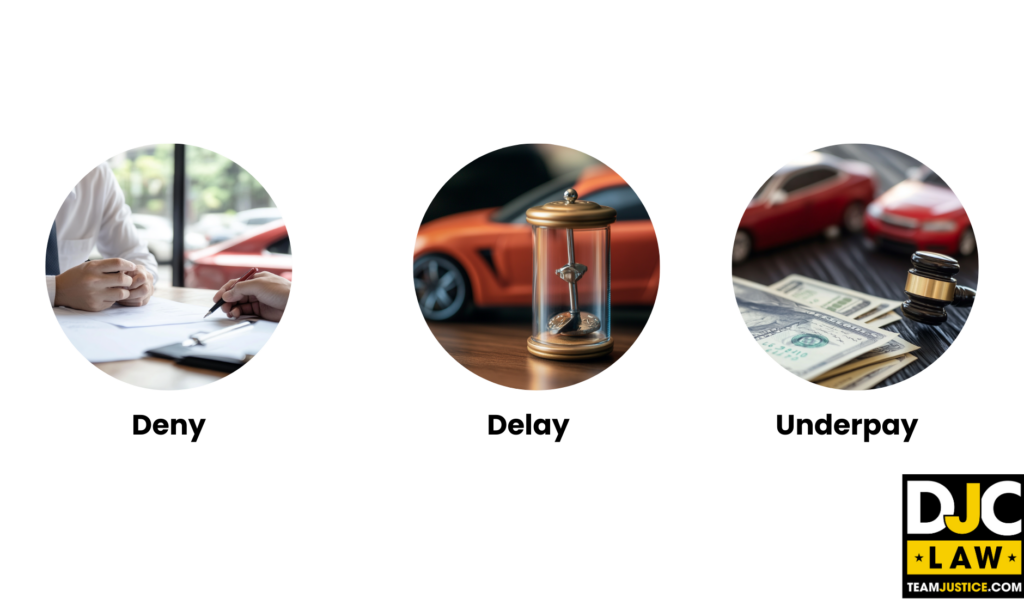Texting and driving is prohibited in 48 of 50 states. The only two states in the US that do not have outright bans on texting and driving are Montana and Missouri.
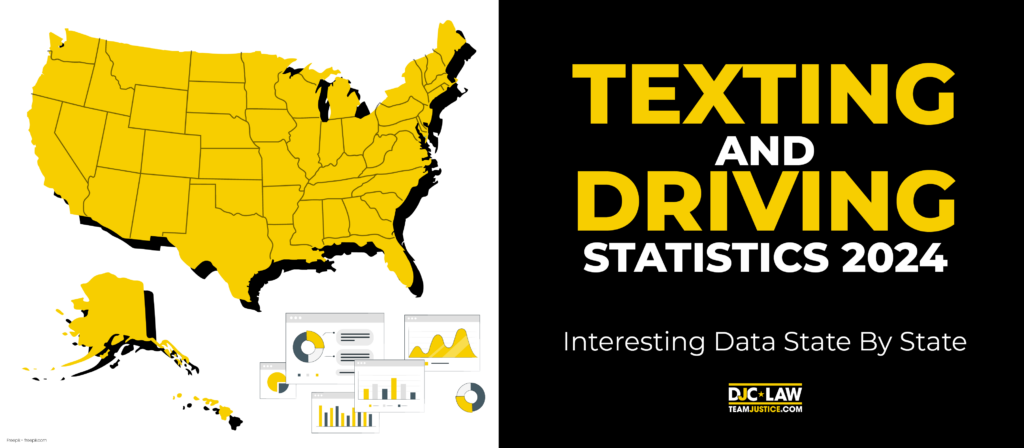
According to data from the Insurance Institute of Highway Safety (IIHS), more than 3,300 people died in distracted driving accidents in 2022. Determining whether texting was the primary cause of an accident is challenging because so many other factors go into what causes an accident.
However, there’s no doubt that being glued to your phone represents a serious threat to your life. In this article, we cover the latest texting and driving statistics and the consequences of picking up your phone to answer a text message or social media post while in motion.
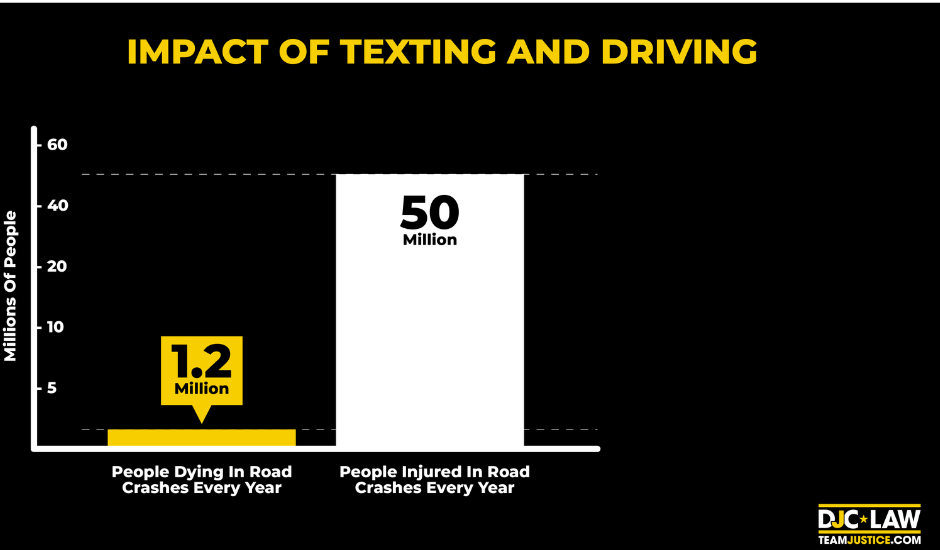
Key Takeaways
More than 3,000 people die every year because of distracted drivers, making U.S. roads among the most dangerous in the Western world.
Roughly 400 Americans are killed every year because of texting and driving incidents.
Texting and driving is a form of distracted driving, which slows your reaction times and makes you less able to perceive and avoid hazards.
49 of 50 states make it illegal to text and drive, with some states even making it an offense to have a cell phone in your hand.
Texting and driving increases your risk of being involved in a fatal crash and leads to tickets, property damage, and potentially even jail time.
Working with a lawyer is crucial to pursue your case and ensure you get the settlement you deserve if you’re involved in an accident with someone who’s texting and driving.
Key Statistics & Trends & Insights
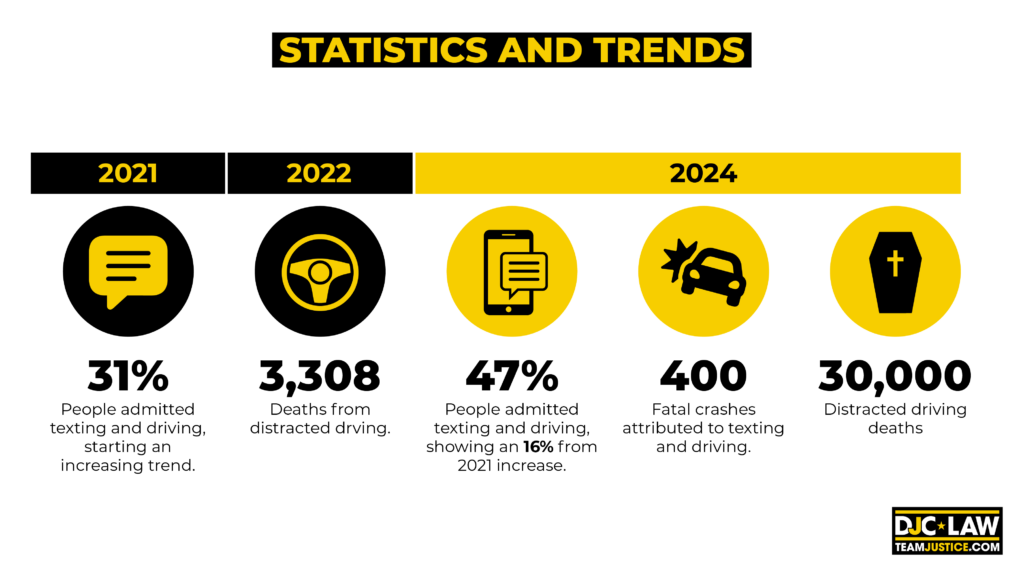
Thousands of Americans have died due to texting and driving, with an average of 400 fatalities every year, according to a report from Forbes. Deaths remain stubbornly constant, but there’s evidence to show that more drivers than ever text and drive.
Here’s a rundown of some of the key texting and driving statistics and trends:
The National Highway Traffic Safety Administration (NHTSA) found that 3,308 people died in motor vehicle crashes because of distracted drivers in 2022.
Around 400 fatal crashes are directly attributed to texting and driving every year, according to Bankrate.
Bankrate also reported that distracted driving deaths as a whole surpass 30,000 every year.
The Zebra conducted a survey and found that the number of drivers who admitted texting and driving in 2024 rose to 47%, up from 31% in 2021.
Texting and driving is likely severely underreported because all statistics are based on police-reported incidents.
What are the Dangers of Texting and Driving?
Texting and driving statistics show that it's dangerous because it’s a form of distracted driving. Whenever you read or send a text, you are taking your eyes and hands away from the road. A few seconds of not paying attention eliminates your ability to detect risks and take evasive action.
Lethal consequences and potentially injuring someone else are the biggest dangers of texting and driving. However, there are other dangers associated with texting on the road, including:
Legal Consequences – Texting and driving is always illegal, meaning you could receive a ticket and a fine. If you cause an accident, you could even see your license suspended or be charged with a felony.
Insurance Rates – Getting ticketed for distracted driving is a moving violation, meaning your auto insurance company could raise your rates because you are considered a “high-risk driver.”
Car Damage – Even if you walk away uninjured, a collision could mean an expensive repair bill. In the worst-case scenario, your car could be totaled, costing you thousands of dollars.
Personal Injury Lawsuits – Getting involved in a car wreck because you were distracted could open you up to being sued by another party for negligence. Without insurance, this could even mean paying your costs out of your own pocket.
As you can see, there are huge consequences to texting behind the wheel that go beyond increasing the risk of injury.
How Texting Impacts Driving Abilities
Texting cripples your driving abilities because your eyes are not focused on the road ahead. Your chances of being involved in a car crash spike due to how texting and driving slows your reaction times. Slower reaction times make it more difficult to avoid mistakes, obstacles, and other hazards.
According to a study from the National Institutes of Health, reading and sending texts from a smartphone forces you to look away from the road. If you look away for five seconds while going at a moderate 55 mph, this is the equivalent of driving the length of a football field with your eyes shut tight.
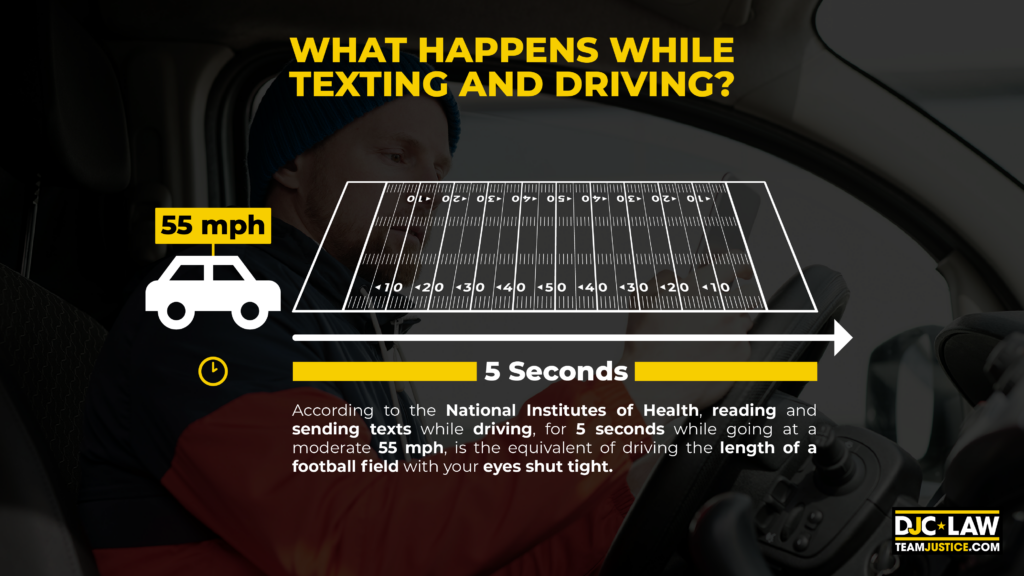
Most regular and commercial motor vehicle drivers would balk at the idea of driving with their eyes closed, but this is precisely what they’re doing when they text and drive.
Comparison to Other Forms of Distracted Driving
Texting and driving is as dangerous as all forms of distracted driving. It’s not the activity but the fact it takes your eyes, hands, and focus away from the road.
According to the Virginia Tech Transportation Institute, they discovered that texting behind the wheel increases your motor vehicle crash risk by 23 times. Texting is not the problem, but what it does to your driving abilities. The risk is the same whether you’re watching the GPS, playing with the radio, or turning to a passenger in the backseat.
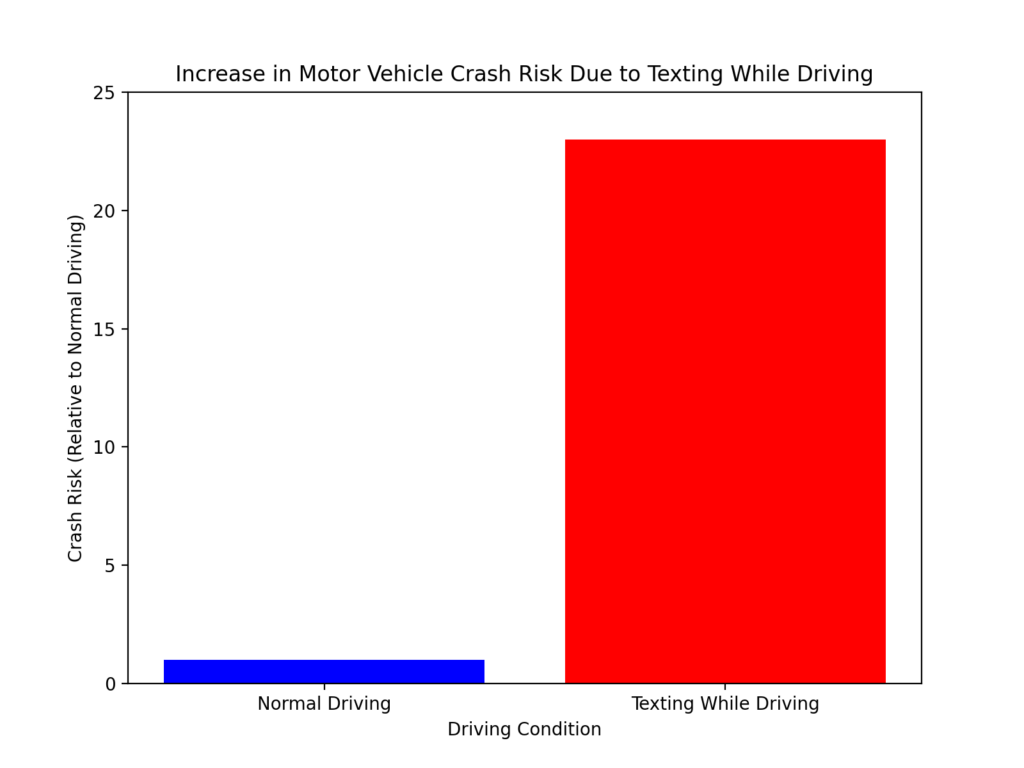
Accident Rates and Fatalities
Around 400 people die every year as a direct result of texting and driving, but more than 30,000 people die from distracted driving.
Everyone from commercial drivers to school bus drivers also fail to understand the risks associated with texting and driving. According to a poll taken by Icebike, 77% of adults said they could manage to text and drive, with 55% of teen drivers saying the same.
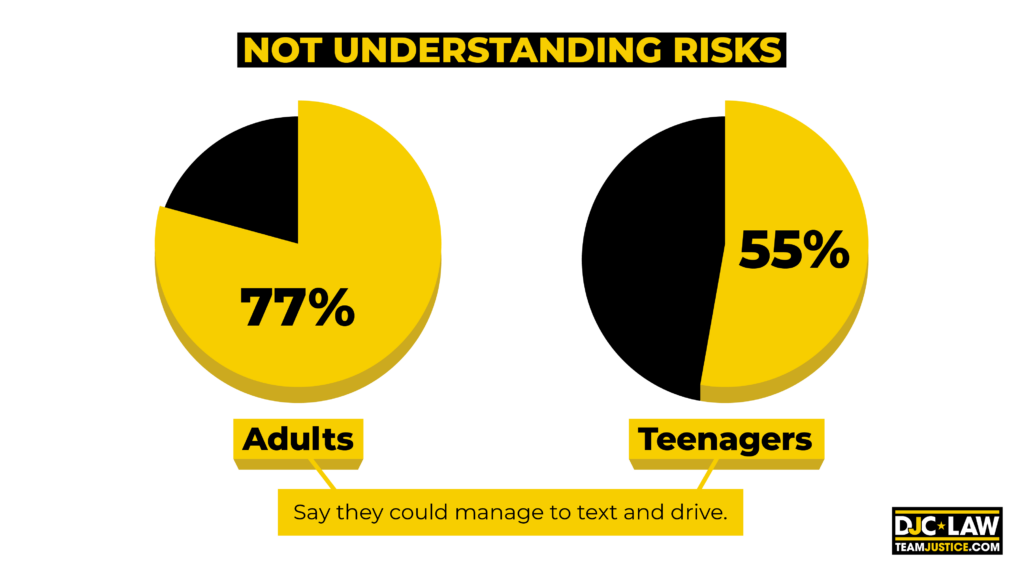
Accident rates are hard to judge because many drivers don’t report that they were using a phone at the time. However, MarketWatch said over 360,000 injuries were attributed to distracted driving in 2021.
It’s clear that accident rates and fatalities are still way too high, and we know that drivers underestimate the risk while overestimating their driving abilities.
What are the Consequences of Texting and Driving?
Texting and driving puts your life and the lives of those around you at risk. Likewise, hundreds of thousands of Americans are injured due to distracted driving every year, with cell phones regularly cited as one of the leading causes. Legal issues, property damage, and getting ticketed are other consequences arising from texting and driving.
Let’s explore these primary consequences of this dangerous behavior:
Injury and Death – Texting on the road increases your chances of being involved in an accident that could injure or kill you or someone else exponentially. Even if you survive, you could be left with life-changing injuries.
Jail Time – Getting a traffic ticket is a guarantee if you’re caught texting, but if a driver distraction causes an accident, you could be charged with a felony, which may result in jail time if it is serious enough.
License Suspension – Texting while driving is a moving violation in many states. Obtaining too many moving violations within a prescribed period could see your license suspended, with a long, expensive process required to get it back.
Higher Rates – Moving violations increase your insurance rates, so if you get caught texting, your next policy renewal could see you paying more for your legally mandated auto insurance policy.
Property Damage – Crashing your car, colliding with someone else’s car, or hitting a stationary object makes you liable for the damages. While your insurance might cover it, you also open yourself up to being sued.
The U.S. Centers for Disease Control (CDC) estimates that nine drivers are killed every year in crashes involving a distracted driver. Even if you think you can drive and text, the fact is that surviving your accident could still impact your life forever.
What’s the Impact of Texting and Driving on Road Safety?
Texting and driving poses a serious threat to road safety as the number of vehicles on the road increases. More distracted drivers mean a greater risk of drivers involved in an accident than ever.
The Population Reference Bureau finds that road traffic accidents continue to increase dramatically worldwide, with 1.2 million people dying in road crashes every year, with as many as 50 million injuries. Although road deaths have decreased in most developed nations, the U.S. is the outlier.
The New York Times found that road safety hasn’t improved in the last decade, in stark contrast to the other richest countries in the world. They estimate that if the U.S. had followed a similar trajectory, 25,000 Americans could have been saved.
The sad fact is that the Insurance Information Institute finds that distracted driving represents 8% of all fatal accidents, with this number also staying remarkably high. Generally, electronic devices and the temptation to get distracted make up a big part of the problem.
Until we can find an answer to the texting and driving problem, America’s roads will continue to be more dangerous than they need to be.
Steps to Take if You’re in an Accident and the Other Driver Was Texting
If the other driver is texting before an accident, they could be liable for your injuries. Proving this requires building a strong case together with your Austin car accident lawyer and ensuring that you claim the compensation you deserve.
What you should do if you’re in an accident with another driver who was texting is to follow these steps:
Step One – Begin by getting yourself to safety and calling for an ambulance if anyone is seriously hurt. Give yourself a once over and then tend to any passengers. If everyone is okay, you can get off the road.
Step Two – Call 911 immediately. Ask for law enforcement to attend so that they can fill out an accident report. If you believe the other driver was texting, you can communicate this to the traffic officer.
Step Three – Exchange details with the other driver. You must do this by law otherwise you could be charged with a hit and run. Make sure you exchange contact and insurance details.
Step Four – Gather evidence using your cell phone. Take pictures of the damage to your vehicle and any visible injuries. Ensuring you grab photos of any signs and the weather conditions can also be helpful.
Step Five – Talk to any eyewitnesses if they were present. They may be able to confirm that the other driver was texting at the time of the accident. Ask them for their contact details, but remember they’re not required to do this.
Step Six – Visit your nearest medical clinic when a police officer has given you the all-clear. The extent of your injuries and medical bills are enormous determining factors in any future settlement. Even if you feel fine, some injuries might not surface for a few hours or days.
Step Seven – Run, don’t walk to your phone, and call a personal injury lawyer. Don’t speak to any car insurance firms, and most certainly, don’t try to handle your own case. If you’ve been involved in a texting and driving accident, your lawyer can advise you further.
Getting involved in an accident is traumatizing, and it can be challenging to know what to do at the time. The number one piece of advice is to prioritize your own safety while keeping a calm head. Let the authorities and your legal counsel do the rest.
What are the Laws of Texting and Driving in Each State?
All states apart from Montana have banned texting and driving. How texting and driving are treated by law enforcement depends on where you are, with some states being stricter than others.
Understanding the texting and driving laws in your state is crucial to knowing where you stand if you’re stopped by the police or you’re involved in an accident with someone who’s texting. However, regardless of what your state says on the issue, you should never text and drive under any circumstances.
Texting and Driving Laws State by State
Each state determines when and where you can use your cell phone in a motor vehicle. However, there may be some quirks regarding how these state laws work. The main difference is that while every state (other than Montana) bans texting while driving, some states go as far as to ban even having a cell phone in your hand.
Here’s a rundown of the texting and driving laws by state as they stand at the time of this writing:
| State | Text Messaging Ban | Hand-Held Ban | Novice Drivers Ban |
|---|---|---|---|
| Alabama | Primary law | No ban | Age 16 and 17 with an intermediate license |
| Alaska | Primary law | No ban | None |
| Arizona | Primary law | Primary law (until Jan 1, 2021 warning) | Instruction and intermediate permit holders under 18 |
| Arkansas | Primary law | School and work zones only | Secondary enforcement under 18 |
| California | Primary law | Primary law | Secondary enforcement under 18 |
| Colorado | Primary law | No ban | Primary law under 18 |
| Connecticut | Primary law | Primary law | Primary law under 18 |
| Delaware | Primary law | Primary law | Primary law with intermediate permit |
| District of Columbia | Primary law | Primary law | Primary law with learner’s permit |
| Florida | Primary law | School and work zones only | None |
| Georgia | Primary law | Primary law | None |
| Guam | Primary law | Primary law | None |
| Hawaii | Primary law | Primary law | Primary law under 18 |
| Idaho | Primary law | No ban | None |
| Illinois | Primary law | Primary law | Primary law under 19 |
| Indiana | Primary law | Primary law | Primary law under 21 |
| Iowa | Primary law | No ban | Primary law with restricted or intermediate license |
| Kentucky | Primary law | No ban | Primary law under 18 |
| Kansas | Primary law | No ban | Primary law with a learner or intermediate license |
| Louisiana | Primary law | School zones only | Primary law with learner’s permit or under 18 |
| Maine | Primary law | Primary law | Primary law with a learner or intermediate permit |
| Maryland | Primary law | Primary law | Primary law under 18 |
| Massachusetts | Primary law | Primary law | Primary law under 18 |
| Michigan | Primary law | No ban | Primary law with level one or two license |
| Minnesota | Primary law | Primary law | Primary law with learner permit under 18 and provisional licenses |
| Mississippi | Primary law | No ban | None |
| Missouri | Primary law (under 21) | No ban | None |
| Montana | No bans | No ban | None |
| Nebraska | Secondary law | No ban | Secondary law under 18 with a learner or intermediate permit |
| Nevada | Primary law | Primary law | None |
| New Hampshire | Primary law | Primary law | Primary law under 18 |
| New Jersey | Primary law | Primary law | Primary law with a permit or provisional license |
| New Mexico | Primary law | No ban | Primary law with a learner or provisional license |
| New York | Primary law | Primary law | None |
| North Carolina | Primary law | No ban | Primary law under 18 |
| North Dakota | Primary law | No ban | Primary law under 18 |
| Ohio | Primary law | No ban | Primary law under 18 |
| Oklahoma | Secondary law | Primary law | None |
| Oregon | Primary law | Primary law | Primary law under 18 |
| Pennsylvania | Primary law | No ban | None |
| Puerto Rico | Primary law | Primary law | None |
| Rhode Island | Primary law | Primary | |
| South Carolina | Primary law | No ban | None |
| South Dakota | Secondary law | Primary law | Secondary law with a learner or intermediate license |
| Tennessee | Primary law (car in motion) | Primary law | Primary law with a learner or intermediate permit |
| Texas | Primary law | School zones and public school property | Primary law under 18 |
| Utah | Primary law | No ban | Primary law under 18 |
| Vermont | Primary law | Primary law | Primary law under 18 |
| Virgin Islands | Primary law | Primary law | None |
| Virginia | Primary law | Primary law (from Jan 1, 2021) | Secondary law under 18 |
| Washington | Primary law | Primary law | Primary law with a learner or intermediate permit |
| West Virginia | Primary law | Primary law | Primary law under 18 |
| Wisconsin | Primary law | Work zones only | Primary law with a learner or intermediate permit |
| Wyoming | Primary law | No ban | None |
| State | First Offense | Second Offense | Subsequent Offenses |
|---|---|---|---|
| Alabama | $25 | $50 | $75 |
| Alaska | Up to $10,000 + up to 1 year jail | N/A | N/A |
| Arizona | $75 - $149 | $150 - $250 | N/A |
| Arkansas | $250 | $500 | Doubles if collision |
| California | $162 (minimum) | $50 + fees | $50 + fees |
| Colorado | $300 | N/A | N/A |
| Connecticut | $200 | $375 | $625 |
| Delaware | $100 | $200 - $300 | N/A |
| Florida | $30 | $60 | N/A |
| Georgia | $50 | $100 | $150 |
| Hawaii | $250 | N/A | N/A |
| Idaho | $131.50 | $206.50 | $356.50 |
| Illinois | $75 | $100 | $125 - $150 |
| Indiana | $35.50 | $250.50 | $500 |
| Iowa | $100 + court costs | N/A | N/A |
| Kansas | $60 + court costs | $250 + 30 days permit suspension | $500 + 90 days suspension |
| Kentucky | $25 | $50 | N/A |
| Louisiana | $175 | $500 | N/A |
| Maine | $250 | License suspension (30 days) | N/A |
| Maryland | $83 | $140 | $160 |
| Massachusetts | $100 | $250 + course | $500 + surcharge + course |
| Michigan | $100 | $200 | N/A |
| Minnesota | $120 | Over $300 | N/A |
| Mississippi | $100 | N/A | N/A |
| Missouri | $85 + court costs | N/A | N/A |
| Montana | No fines | N/A | N/A |
| Nebraska | $200 | $300 | $500 |
| Nevada | $50 | $100 | $250 |
| New Hampshire | $100 | $250 | $500 |
| New Jersey | $200 | $400 | $600 + possible suspension |
| New Mexico | $25 | $50 | N/A |
| New York | $50 - $200 | $50 - $250 | $50 - $450 + $93 surcharge |
| North Carolina | $100 + court costs | N/A | N/A |
| North Dakota | $100 | N/A | N/A |
| Ohio | $150 | $150 (under 18: 60 days suspension) | $300 (year suspension) |
| Oklahoma | $100 | N/A | N/A |
| Oregon | $1,000 maximum | $2,000 maximum | $2,000 - $2,500 + up to 6 months jail |
| Pennsylvania | $50 + court costs | N/A | N/A |
| Rhode Island | Up to $100 | N/A | N/A |
| South Carolina | Up to $25 | N/A | N/A |
| South Dakota | $122.50 | N/A | N/A |
| Tennessee | $50 | Up to $100 | N/A |
| Texas | $25 - $99 | $100 - $200 | N/A |
| Utah | Up to $100 | N/A | Up to $1,000 + jail |
| Vermont | $100-$200 | $250-$500 | N/A |
| Virginia | $125 | $250 | N/A |
| Washington | $136 | $234 | N/A |
| West Virginia | $100 | $200 | $300 + court costs |
| Wisconsin | $20 | Up to $400 | N/A |
| Wyoming | $75-$90 | N/A | N/A |

